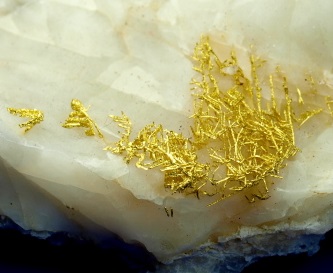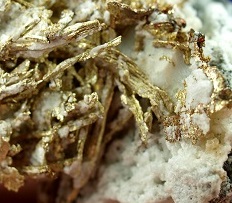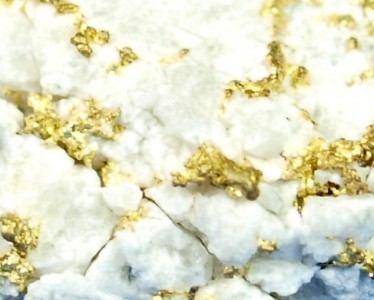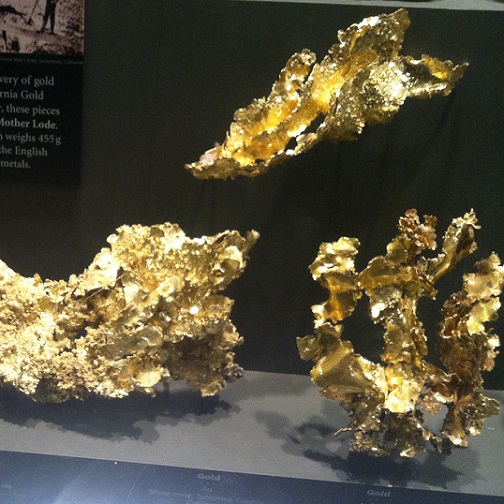 Crystalline gold is highly sought after in the collectors gold market. Unlike normal placer gold that is found in more common dust, flakes, and smooth water-worn nuggets, gold that has natural crystalline structure is exceptionally rare, and rare mineral collectors will pay a nice premium for exceptionally nice pieces.
Crystalline gold is highly sought after in the collectors gold market. Unlike normal placer gold that is found in more common dust, flakes, and smooth water-worn nuggets, gold that has natural crystalline structure is exceptionally rare, and rare mineral collectors will pay a nice premium for exceptionally nice pieces.
Crystalline gold is not all created equal. There are many different types of formations, and certain regions and mines are known for producing a specific type of gold. Experienced gold collectors can often tell exactly where a piece of gold is from simply by looking at its crystalline structure.
From a buyer’s standpoint, evaluating a specimen for purchase is highly dependent on the overall aesthetic beauty of the piece. While most crystalline gold will bring a premium price above its melt value, the price that it will bring can vary widely from just a small percentage above spot price to many times spot price.
Some exceptional gold specimens will sell for 10-20 times their melt value, but pieces like this are quite rare.
How does crystalline gold form?
There are still many unknowns about gold and its formation, particularly the various shapes that natural crystalline gold can form in.
 The formation of gold itself within the Earth’s crust happens when there are extreme high-heat events that occur during extreme geological events. This is the reason that so much of the Earth’s gold is found in mountains that formed from colliding tectonic plates. Two land masses come together causing extreme temperature fluctuation and gold forms as a result.
The formation of gold itself within the Earth’s crust happens when there are extreme high-heat events that occur during extreme geological events. This is the reason that so much of the Earth’s gold is found in mountains that formed from colliding tectonic plates. Two land masses come together causing extreme temperature fluctuation and gold forms as a result.
However, these gold formations can form in a variety of ways. The deposits themselves generally form as small veins within a hard rock source. This gold is generally coarse, but it isn’t necessarily crystalline in shape.
Exposed gold veins on the surface erode and release gold, eventually resulting in placer deposits of dust, flakes, and nuggets. But prior to reaching the watercourse they will remain in their generally rough shape.
This is a primary distinction of crystalline gold. Since gold is an extremely soft metal, it doesn’t take a lot of time, geologically speaking, for it to become rounded, tumbled, and smoothed out into a more typical nugget shape.
It is the softness of gold itself that is the reason that most of the gold nuggets that we are accustomed to seeing are more rounded in that classic “nugget” shape. Continuous erosion can further break gold apart into even smaller pieces.
Gold that has come directly from the vein will naturally be a rougher texture, but it is not necessarily crystalline. This type of rough gold is often less collectable than more average nuggets, and certainly less-so than crystalline gold. In some instances it will actually be quite ugly with iron staining and really doesn’t need to be saved as a collectable piece. Rather it can be crushed and processed for its gold content alone.
The various shapes that can naturally form within gold are amazing. Specimens can form cubes, dendrites or dendritic patterns, thin leaf and sheet forms, octahedrons, and many other ways that are more commonly associated with gem crystals rather than gold.
Mines and Districts Known for Crystalline Gold
Crystalline gold can potentially form anywhere than natural gold deposits are found, but past experience tells us that there are certain specific locations that are known to produce this very specific type of gold. Additionally, there are specific formations that are only known to occur at one particular mine, or within just a very limited area within a mining district.
In the United States, Nevada is fairly well-known for producing some really exceptional pieces of gold with fascinating crystal formations. Many different mining districts throughout the state have them, and additionally there are some large commercial mining operations that extract rare specimens straight from the hard rock sources.
 One place that is known for some really interesting gold are the Majuba Placers, an area also known as Rye Patch, located in Pershing County south of Winnemucca near Rye Patch Reservoir. This is a district that is fairly expansive but has no available water for mining, so nearly all of the gold here has been found by small-scale prospectors using metal detectors and drywashers.
One place that is known for some really interesting gold are the Majuba Placers, an area also known as Rye Patch, located in Pershing County south of Winnemucca near Rye Patch Reservoir. This is a district that is fairly expansive but has no available water for mining, so nearly all of the gold here has been found by small-scale prospectors using metal detectors and drywashers.
A formation called Chevron gold is found here. This is a fascinating structured gold that is found only at Rye Patch and a few surrounding gold districts. Chevron gold is highly collectable, and due to the fact that this area has been mined hard since the 1930s, there are less and less of these gold nuggets available on the market. They are quite rare today and command a nice premium to collectors.
The Round Mountain Gold Mine is another place that produces some exceptional and very interesting gold specimens. Located in Nye County, this is the largest operating gold mine in the United States. While the gold that is mined here is primarily microscopic in size and mined on a massive commercial scale, there are also nice specimens that are mined and recovered.
Many areas in northern California’s Mother Lode country have also produced crystalline gold. In fact, some of the largest crystalline pieces ever found in the US come from here. The Fricot Nugget is currently believed to be the largest existing piece of crystalline gold.
Some exceptional pieces of Crystalline California gold are on display at the Smithsonian Museum in Washington D.C.
There are several mines in Colorado that produce some interesting specimen gold as well. These pieces are usually not very large, but instead are “thumbnail” sized pieces. Still, the shapes and structures of these specimens can be extremely interesting.
Pricing
As mention previously, the prices that can be obtained for crystalline gold can vary widely, from just a small amount over the melt value of gold to many times the price of gold.
When considering the overall value of a crystalline gold specimen of high quality, the amount of actual gold in the piece is generally just an afterthought. Just like a high-grade gemstone; it isn’t just about size, but mainly quality.
Diamonds are really a good example for comparison. There are commercial grade diamonds that are used in all kinds of industrial uses. They are off-color and have relatively low value. Then there are exceptional large, bright diamonds that are worth thousands of dollars.
High-grade crystalline gold is the same way. The best pieces are worth what someone is willing to pay, and many collectors will pay extremely high amounts of the best pieces.

Some of the spectacular crystalline gold specimens on display at the Smithsonian Museum in Washington D.C.
Explore these 19 Mining Areas with BIG Gold Nuggets
Gold Specimens from the 16 to 1 Gold Mine
156 Ounce Gold Nugget Found with a Detector!







